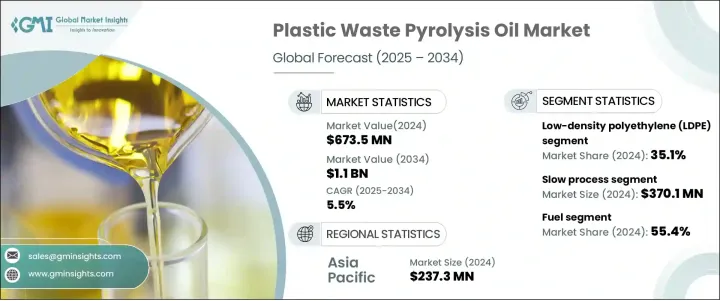
|
시장보고서
상품코드
1716534
폐플라스틱 열분해 오일 시장 : 기회, 성장 촉진요인, 산업 동향 분석 및 예측(2025-2034년)Plastic Waste Pyrolysis Oil Market Opportunity, Growth Drivers, Industry Trend Analysis, and Forecast 2025 - 2034 |
||||||
세계의 폐플라스틱 열분해 오일 시장은 2024년에 6억 7,350만 달러로 평가되었으며, 2025년부터 2034년까지 연평균 성장률(CAGR) 5.5%로 성장할 것으로 예측됩니다.
이 시장은 전 세계 산업계와 정부가 지속 가능한 폐기물 관리 솔루션을 점점 더 강조하고 화석 연료에 대한 의존도를 줄이기 위해 대체 연료 공급원을 모색함에 따라 꾸준히 성장하고 있습니다. 폐플라스틱을 산소가 없는 환경에서 열분해하여 얻은 폐플라스틱 열분해 오일은 재활용이 불가능한 플라스틱을 가치 있는 연료와 원료로 전환하는 실행 가능한 솔루션으로 떠오르고 있습니다. 폐기물을 최소화하고 자원 효율성을 증진하기 위한 순환 경제 관행으로의 전환이 증가하면서 시장 확대가 가속화되고 있습니다. 열분해 오일은 온실가스 배출을 줄이고 에너지 효율성을 개선하며 운송 연료, 산업용 난방유, 석유화학 원료에 대한 수요 증가를 지원할 수 있는 능력으로 인해 주목을 받고 있습니다. 열분해 기술의 발전으로 공정 효율성이 향상되고 운영 비용이 절감됨에 따라 폐플라스틱 열분해 오일 시장은 크게 성장할 것으로 예상됩니다.

시장은 공급 원료를 기준으로 세분화되며, 2024년에는 저밀도 폴리에틸렌(LDPE)이 35.1%로 가장 큰 점유율을 차지할 것으로 예상됩니다. 비닐봉지 및 필름과 같은 포장재에 널리 사용되는 LDPE는 녹는점이 낮고 수율 효율이 높기 때문에 열분해의 주요 후보로 남아 있습니다. LDPE 폐기물은 기계적 공정을 통한 재활용이 어렵기 때문에 열분해와 같은 화학적 재활용 방법에 대한 수요가 증가하고 있습니다.
| 시장 범위 | |
|---|---|
| 시작 연도 | 2024년 |
| 예측 연도 | 2025-2034년 |
| 시작 금액 | 6억 7,350만 달러 |
| 예측 금액 | 11억 달러 |
| CAGR | 5.5% |
폐플라스틱 열분해 오일 시장은 공정 유형별로도 분류되며, 2024년에는 저속 열분해가 3억 7,010만 달러의 가치를 창출할 것으로 예상됩니다. 저속 열분해는 오일 수율과 안정성이 높기 때문에 열분해 오일을 생산하는 데 선호되는 방법입니다. 300-500°C의 낮은 온도에서 작동하고 체류 시간이 길어지는 이 공정은 보다 효율적인 열분해를 보장하여 액체 연료 생산량을 늘릴 수 있습니다. 대규모 상업용에 가장 비용 효율적인 옵션으로, 운영 비용을 최소화하면서 수율을 극대화하고자 하는 업계에서 선호되는 방식입니다.
아시아태평양의 폐플라스틱 열분해 오일 산업은 2024년 2억 3,730만 달러를 창출해 2034년까지 연평균 성장률(CAGR) 5.7%로 성장할 것으로 예측됩니다. 이 지역의 지배력은 급속한 산업화, 도시화, 광범위한 플라스틱 사용에 의해 촉진되고 있습니다. 아시아태평양 지역의 여러 국가에서는 증가하는 폐플라스틱 문제를 해결하기 위해 열분해 플랜트 개발에 막대한 투자를 하고 있습니다. 폐기물 에너지화 기술과 지속 가능한 관행에 중점을 두고 있는 이 지역은 폐플라스틱을 가치 있는 자원으로 전환하기 위한 전 세계적인 변화를 주도하고 있습니다. 환경 지속 가능성과 폐기물 관리 혁신에 대한 이러한 노력은 아시아태평양과 그 밖의 지역에서 폐플라스틱 열분해 오일에 대한 수요를 지속적으로 증가시키고 있습니다.
목차
제1장 조사 방법과 조사 범위
제2장 주요 요약
제3장 업계 인사이트
- 생태계 분석
- 밸류체인에 영향을 주는 요인
- 이익률 분석
- 혁신
- 장래의 전망
- 제조업체
- 유통업체
- 공급자의 상황
- 이익률 분석
- 주요 뉴스
- 규제 상황
- 영향요인
- 성장 촉진요인
- 정부의 유리한 대처
- 급속한 도시화와 산업화
- 도시 고형 폐기물(MSW) 양 증가
- 업계의 잠재적 위험 및 과제
- 높은 생산 비용
- 성장 촉진요인
- 성장 가능성 분석
- Porter's Five Forces 분석
- PESTEL 분석
제4장 경쟁 구도
- 소개
- 기업 점유율 분석
- 경쟁 포지셔닝 매트릭스
- 전략 전망 매트릭스
제5장 시장 규모와 예측 : 원료별(2021-2034년)
- 주요 동향
- 저밀도 폴리에틸렌(LDPE)
- 고밀도 폴리에틸렌(HDPE)
- 폴리프로필렌(PP)
- 기타
제6장 시장 규모와 예측 : 프로세스별(2021-2034년)
- 주요 동향
- 패스트
- 플래시
- 슬로우
제7장 시장 규모와 예측 : 최종 용도별(2021-2034년)
- 주요 동향
- 연료
- 화학
- 열 및 전력
- 기타
제8장 시장 추계 및 예측 : 지역별(2021-2034년)
- 주요 동향
- 북미
- 미국
- 캐나다
- 유럽
- 독일
- 영국
- 프랑스
- 스페인
- 이탈리아
- 네덜란드
- 아시아태평양
- 중국
- 인도
- 일본
- 호주
- 한국
- 라틴아메리카
- 브라질
- 멕시코
- 중동 및 아프리카
- 사우디아라비아
- 남아프리카
- 아랍에미리트(UAE)
제9장 기업 프로파일
- Nexus Circular
- OMV Aktiengesellschaft
- Niutech Environment Technology Corporation
- Klean Industries
- Fortum OyJ
- Enerkem
- Ensyn Corporation
- Twence BV
- Agilyx Corporation
- Green Fuel Nordic Corporation
- Vadxx Energy LLC
- Quantafuel AS
- RESYNERGI
- JBI Inc.
The Global Plastic Waste Pyrolysis Oil Market generated USD 673.5 million in 2024 and is projected to grow at a CAGR of 5.5% between 2025 and 2034. This market is experiencing steady growth as industries and governments worldwide increasingly emphasize sustainable waste management solutions and seek alternative fuel sources to reduce dependence on fossil fuels. Plastic waste pyrolysis oil, derived from the thermal decomposition of plastic waste in an oxygen-free environment, is emerging as a viable solution for converting non-recyclable plastics into valuable fuels and feedstock. The increasing shift toward circular economy practices, aimed at minimizing waste and promoting resource efficiency, is driving market expansion. Pyrolysis oil is gaining traction due to its ability to reduce greenhouse gas emissions, improve energy efficiency, and support the growing demand for transport fuels, industrial heating oils, and petrochemical feedstock. With advancements in pyrolysis technologies enhancing process efficiency and reducing operational costs, the market for plastic waste pyrolysis oil is poised for significant growth.

The market is segmented based on feedstock, with low-density polyethylene (LDPE) holding the largest share at 35.1% in 2024. LDPE, widely used in packaging materials such as plastic bags and films, remains a prime candidate for pyrolysis due to its lower melting point and high yield efficiency. As LDPE waste is difficult to recycle through mechanical processes, the demand for chemical recycling methods like pyrolysis is increasing. LDPE-derived pyrolysis oil is becoming an attractive alternative fuel source, especially as governments implement stringent regulations on landfills and promote waste-to-energy systems to reduce environmental impact.
| Market Scope | |
|---|---|
| Start Year | 2024 |
| Forecast Year | 2025-2034 |
| Start Value | $673.5 Million |
| Forecast Value | $1.1 Billion |
| CAGR | 5.5% |
The plastic waste pyrolysis oil market is also classified by process type, with slow pyrolysis generating USD 370.1 million in 2024. Slow pyrolysis is the preferred method for producing pyrolysis oil because of its higher oil yield and stability. Operating at lower temperatures between 300-500°C and extended residence times, this process ensures more efficient thermal decomposition, resulting in increased liquid fuel production. It remains the most cost-effective option for large-scale commercial applications, making it a preferred choice for industries aiming to maximize yield while minimizing operational costs.
The Asia Pacific Plastic Waste Pyrolysis Oil Industry generated USD 237.3 million in 2024 and is expected to grow at a CAGR of 5.7% by 2034. The region's dominance is fueled by rapid industrialization, urbanization, and widespread plastic usage. Several countries across Asia Pacific are investing heavily in developing pyrolysis plants to address the rising issue of plastic waste. With a strong focus on waste-to-energy technologies and sustainable practices, the region is leading the global shift toward converting plastic waste into valuable resources. This increasing commitment to environmental sustainability and innovation in waste management continues to drive demand for plastic waste pyrolysis oil in Asia Pacific and beyond.
Table of Contents
Chapter 1 Methodology & Scope
- 1.1 Market scope & definition
- 1.2 Base estimates & calculations
- 1.3 Forecast calculation
- 1.4 Data sources
- 1.4.1 Primary
- 1.4.2 Secondary
- 1.4.2.1 Paid sources
- 1.4.2.2 Public sources
- 1.5 Primary research and validation
- 1.5.1 Primary sources
- 1.5.2 Data mining sources
Chapter 2 Executive Summary
- 2.1 Industry synopsis, 2021-2034
Chapter 3 Industry Insights
- 3.1 Industry ecosystem analysis
- 3.1.1 Factor affecting the value chain
- 3.1.2 Profit margin analysis
- 3.1.3 Disruptions
- 3.1.4 Future outlook
- 3.1.5 Manufacturers
- 3.1.6 Distributors
- 3.2 Supplier landscape
- 3.3 Profit margin analysis
- 3.4 Key news & initiatives
- 3.5 Regulatory landscape
- 3.6 Impact forces
- 3.6.1 Growth drivers
- 3.6.1.1 Favourable government initiatives
- 3.6.1.2 Rapid urbanization and industrialization
- 3.6.1.3 Increasing amount municipal solid waste (MSW)
- 3.6.2 Industry pitfalls & challenges
- 3.6.2.1 High production costs
- 3.6.1 Growth drivers
- 3.7 Growth potential analysis
- 3.8 Porter's analysis
- 3.9 PESTEL analysis
Chapter 4 Competitive Landscape, 2024
- 4.1 Introduction
- 4.2 Company market share analysis
- 4.3 Competitive positioning matrix
- 4.4 Strategic outlook matrix
Chapter 5 Market Size and Forecast, By Feedstock, 2021 – 2034 (USD Million, Tons)
- 5.1 Key trends
- 5.2 Low density polyethylene (LDPE)
- 5.3 High density polyethylene (HDPE)
- 5.4 Polypropylene (PP)
- 5.5 Others
Chapter 6 Market Size and Forecast, By Process, 2021 – 2034 (USD Million, Tons)
- 6.1 Key trends
- 6.2 Fast
- 6.3 Flash
- 6.4 Slow
Chapter 7 Market Size and Forecast, By End Use, 2021 – 2034 (USD Million, Tons)
- 7.1 Key trends
- 7.2 Fuel
- 7.3 Chemicals
- 7.4 Heat & power
- 7.5 Others
Chapter 8 Market Estimates and Forecast, By Region, 2021 – 2034 (USD Million) (Tons)
- 8.1 Key trends
- 8.2 North America
- 8.2.1 U.S.
- 8.2.2 Canada
- 8.3 Europe
- 8.3.1 Germany
- 8.3.2 UK
- 8.3.3 France
- 8.3.4 Spain
- 8.3.5 Italy
- 8.3.6 Netherlands
- 8.4 Asia Pacific
- 8.4.1 China
- 8.4.2 India
- 8.4.3 Japan
- 8.4.4 Australia
- 8.4.5 South Korea
- 8.5 Latin America
- 8.5.1 Brazil
- 8.5.2 Mexico
- 8.6 Middle East and Africa
- 8.6.1 Saudi Arabia
- 8.6.2 South Africa
- 8.6.3 UAE
Chapter 9 Company Profiles
- 9.1 Nexus Circular
- 9.2 OMV Aktiengesellschaft
- 9.3 Niutech Environment Technology Corporation
- 9.4 Klean Industries
- 9.5 Fortum OyJ
- 9.6 Enerkem
- 9.7 Ensyn Corporation
- 9.8 Twence B.V.
- 9.9 Agilyx Corporation
- 9.10 Green Fuel Nordic Corporation
- 9.11 Vadxx Energy LLC
- 9.12 Quantafuel AS
- 9.13 RESYNERGI
- 9.14 JBI Inc.



















